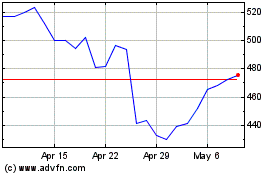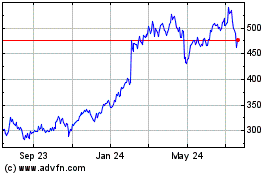Lawsuit Accuses Facebook of Knowing Ad Audiences Were Inflated -- Update
March 21 2020 - 12:28AM
Dow Jones News
By Jeff Horwitz
Facebook Inc. employees were aware that the company was
overestimating how many people advertisers could reach, according
to an amended complaint filed this week in a nearly two-year-old
lawsuit accusing the company of misrepresenting that data.
"This is a lawsuit waiting to happen," a Facebook product
manager wrote to colleagues in October 2018, regarding the
company's alleged overstatements, according to the amended
complaint filed Thursday. The emails were produced as part of the
discovery process in the lawsuit, which is seeking class-action
status and was originally filed by a small-business owner in
federal court in San Francisco in 2018.
"These allegations are without merit and we will defend
ourselves vigorously," a spokesperson for Facebook said in a
statement.
The company has previously said the estimates were never meant
to be precise guarantees and couldn't plausibly have harmed
customers.
Facebook defines the "potential reach" to advertisers as an
estimate of an ad's target audience. According to the amended
lawsuit, Facebook's potential reach among the 18- to 34-year-old
demographic in every state exceeded the actual population of those
18- to 34-years-old.
This isn't the first time Facebook has been accused of inflating
metrics relied upon by advertisers. In 2016, the company disclosed
that it had overestimated viewing time for video ads. Advertisers
sued after the disclosure, and Facebook later settled that lawsuit,
saying it made an error in calculating its metrics and denying the
other allegations.
According to the amended lawsuit, Facebook first learned about
concerns that it was misleading customers about how many people
could see their ads in 2015 but did nothing about it. The complaint
says Facebook held at least four meetings in early 2018 to discuss
the alleged reach inflation but didn't provide further details.
In the 2018 email, the product manager likened the alleged
overstatement to the 2016 revelation that Facebook's video
viewership statistics were erroneously inflated.
Other employees shared the product manager's concern, according
to the amended lawsuit. "My question lately is: How long can we get
away with the reach overestimation?" one employee wrote, according
to the Thursday filing.
Some sections of the complaint are redacted, including
descriptions of emails written and actions taken allegedly by Chief
Operating Officer Sheryl Sandberg and other executives.
The alleged potential audience errors wouldn't directly affect
what Facebook's customers paid for ads because they were a
measurement of how many people could potentially see an ad, not
whether actual users viewed or clicked on it. But Brian Wieser, a
former Pivotal Research analyst who noted the apparent
overstatements in how many U.S. residents Facebook claimed
advertisers could reach in a 2017 research note, said the size of
the audience reachable on a platform is a meaningful metric to
advertisers.
A higher potential reach "makes you relatively more attractive
compared to another media owner," said Mr. Wieser, now president of
global business intelligence at advertising conglomerate Group
M.
According to the amended lawsuit, Facebook internally
acknowledged that the inflated numbers were "due to duplicate and
fake accounts." But rather than cleaning up the metric, the company
allegedly created talking points attributing the apparent mismatch
to people traveling, according to the suit.
In March 2019, Facebook announced that it was changing how it
measures potential reach to exclude users who were active on the
platform but were not shown ads in the past month. The company also
has added caveats to its explanation of its potential reach metric,
saying it "isn't intended to align with third-party calculations or
population census data."
According to the amended lawsuit, that fix was only partial, and
the metric still doesn't correspond to the possible audience of
real people who might see an ad.
Write to Jeff Horwitz at Jeff.Horwitz@wsj.com
(END) Dow Jones Newswires
March 21, 2020 00:13 ET (04:13 GMT)
Copyright (c) 2020 Dow Jones & Company, Inc.
Meta Platforms (NASDAQ:META)
Historical Stock Chart
From Mar 2024 to Apr 2024

Meta Platforms (NASDAQ:META)
Historical Stock Chart
From Apr 2023 to Apr 2024
